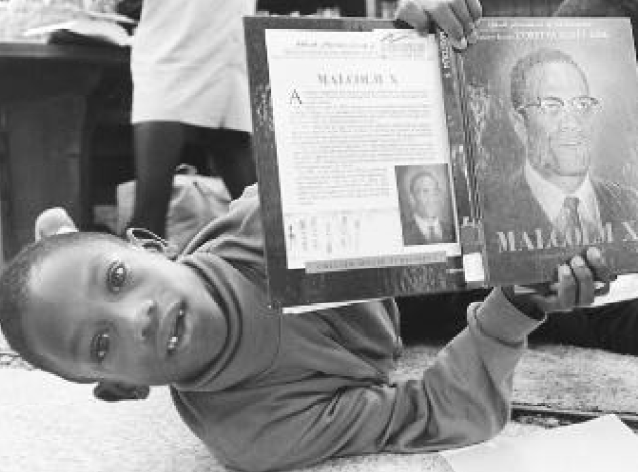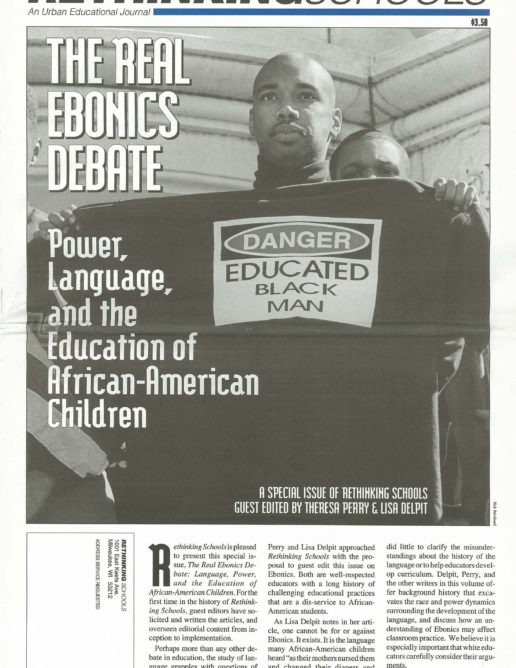Ebonics: Myths and Realities

African-American communities are in educational crisis. Given the well-documented history of schools’ failure to teach African-American children, the Oakland School Board’s resolution on Ebonics is a rare position in American education.
The board decided that Ebonics/African American Language should be used as a bridge to teaching Standard English. The goal is realizable, yet several myths abound: that Ebonics is limited as a tool to teaching Standard English because it is just “bad grammar,” “lazy pronunciation,” and slang; that there is no research linking Ebonics to education; that literacy problems among African-American children are really the parents’ fault; and that the debate over Ebonics has been useless.
Myth #1: Ebonics is just bad grammar, lazy pronunciation, and slang.
The term Ebonics was coined by Dr. Robert Williams at a conference in 1973 (see article by Ernie Smith on page 14). The language itself has existed since the arrival of Blacks in the United States, according to Dr. Lorenzo Turner, whose seminal work Africanisms in the Gullah Dialect lists 4,000 African words in the Gullah language on islands off the coast of South Carolina.
Many who condemn Ebonics refer to it as “bad grammar,” “lazy pronunciation,” or slang. However, linguist Dell Hymes notes that, viewed sociolinguistically, language is much more than characteristics such as grammar or pronunciation (phonology). In fact, Ebonics/African American Language has a number of other characteristics, including semanics, intonation, sociolinguistic rules, speaking style, learning and teaching style, favored genres, and world view/ themes. It is important that teachers be given a broad description of the language of Ebonics in order to understand its complexity, the complexity of its speakers, and the role of Ebonics in teaching language arts. Following are examples of some of the characteristics of Ebonics.1
Grammar and Pronunciation. An example of Ebonics grammar is the habitual use of the verb, as in “I be going to church,” which means “I go habitually.” West African verbs have similar structures. A phonological example is the fact that consonants and consonant clusters are often not a part of the Ebonics syllable. For example, “I ‘on know” for “I don’t know,” or “aight” for “all right.”
Semantics. A vocabulary/semantics example is the use of inversion, as when a beautiful dress is described as “stupid” or something good is called “bad.”
Intonation. The African-American speaker has a wide range in his/her tone, much wider than for whites — for example Dr. Martin Luther King’s “I have a dreeeeam today.” It is this Africanized intonation that informs us that a person we can hear but not see is African American.
Favored Genres. Favored genres for Ebonics speakers are drama, proverbs, and poetry/rap.
Sociolinguistic Rules. Such rules include the avoidance of taboo words — layovers from Southern apartheid — such as “boy,” “you people.” Another such rule is the approval of using Ebonics in oral or casual situations but not in written or formal situations, such as in textbooks.
Speaking Style and Learning and Teaching Style. Examples of speaking style are dramatic repetition (“I Have a Dream”), the Call and Response Style, and the use of rhyming and circular narratives. Under learning and teaching style, we find the use of Audience Participation and Structure, such as the use of structured phonics reading methodology, which is a reading method frequently and effectively used in teaching the bilingual/ bidialectical Ebonics speaker.
World View/Themes.As defined by Brazilian educator Paulo Freire, generative themes are those themes that stir a culture to learn faster. For Ebonics speakers, such themes include affirmation (such as self-determination), protest, the wretchedness of oppression, and the avoidance of stereotypes, according to the late Sterling Brown, professor of literature, at Howard University. For example, there are four prevalent stereotypes of African Americans: the Exotic Primitive, the Contented Slave, the Brute, and the Comic. Several issues in the Ebonics debate can only be explained by the need to avoid these stereotypes. For example, the rejection of the Oakland School Board Ebonics resolution by some African Americans is probably due to the desire to avoid the stereotypes of the Exotic Primitive and the Comic, with the Exotic Primitive perceived as so different and exotic that his/her language is a joke.
Myth #2: There is no research linking Ebonics to education.
Research supports the Standard English Proficiency Program used by the Oakland District. The program stresses Ebonics as a bridge to teaching literacy to African-American students. Its emphasis is on teaching students Standard English speaking skills, on teaching the teachers about the Ebonics speakers’ language and culture, and on teaching reading through “Superliteracy,” which endorses phonics in addition to eight other components (Bazely, 1996). If there is a main culprit in the reading problems facing Ebonics speakers, it is the flight from phonics.
There is a 30-year track record for teaching reading to Ebonics speakers, from Jean Chall’s Learning to Read: The Great Debate in 1967, to Successful Black and Minority Schools, a 1990 book edited by myself and Norma Dabney and Shirley Lewis, to B.R. Foorman’s work at the University of Houston in 1995. The record is clear: African-American students who speak Ebonics can be taught to read at high levels using any one of several phonics-based reading programs. These highly structured, intensive approaches are appropriate for Ebonics-speaking students because they are similar to foreign language teaching methods — with students first being exposed to regular patterns (phonics), then passages written in these patterns.
The only battery of tests for Ebonics speakers, formally published in the “1996 Handbook of Tests and Measurements for Black Populations,” was conducted by Stanford University’s Program on Teaching and Linguistic Pluralism from 1969 to 1980. The research involved more than 100 teachers and hundreds of students in California, New York, Ohio, and Florida. It found that teachers who had highly positive attitudes and expectations toward Ebonics speakers, as well as more information about Ebonics characteristics and how to teach such speakers, were those whose students gained the most over a five-month test period. A second Stanford study, also cited in the 1996 Handbook, showed that the ability to discriminate between Standard English and Ebonics significantly correlates with reading ability among African-American students.
Publishers, however, have a history of marketing materials based on flimsy research for the sole purpose of making money. This can be seen in the recent “whole language” debacle, in which a method devoid of any research regarding its effectiveness was foisted on public schools. Though all students suffered from this educational malpractice, African-American and other students with different languages in their backgrounds were particular victims. In 1994, California became the first state to legislate that teachers must have a “balanced” approach to the teaching of reading, one that includes both literature and phonics.
Myth #3: Literacy problems among African-American children are really the parents’ fault.
Successful schools do not rely on parents to teach their children to read (Hoover, Dabney, and Lewis, 1990). In actuality, it is the responsibility of the school administration to be the catalyst for changing the schools and ensuring appropriate teaching of literacy to African-American children. Parents and community members, however, can force substantive change. Although curriculum theory textbooks used by schools of education never mention the role of community boards and organizations in curriculum reform, the Oakland Board of Education has shown that communities can force curriculum reform.
African-American parents and community members have fought for literacy throughout history — most notably during the days of slavery, when it was illegal in slave states to teach African Americans to read, and on through the Freedom Schools during the civil rights and Black Power era, the formation of independent Black schools in the 1960s and 1970s, and reforms in some public schools in more recent decades. Yet these movements have often been unimplemented, mis-implemented, or ignored by public schools administrations — to the extent that there is no school district in the country performing at level in which the students are predominantly African American or other students of color.
Myth #4: The debate over Ebonics has been useless.
Yes, the children suffer while we debate. Structural linguists, sociolinguists, and applied linguists battle over terminology. Some linguists criticize everyone. Still others are busy writing “dialect readers.” And many educators dismiss the entire issue as irrelevant and take very little interest in solving the problems of Black illiteracy.
The Ebonics project, with its emphasis on phonic-inclusive literacy methods and on improving teacher attitudes (one of the major characteristics of a successful school), may solve the problem of Black illiteracy — if the recommendations of the Task Force for African-American Education are implemented. For administrators, teachers, parents, and community activists who decide to implement the research on bringing African-American students up to and above grade level, the research — available through the education data base ERIC and in library card catalogs — has been there since 1967.
If public schools are to survive, they must find a solution to the systematic failure to teach African-American children. Parents consider reading to be the most important outcome of schooling, and employers view it as one of the most important skills for a worker in the 21st century. Yet discussions of the appropriate methods for teaching literacy to African-American children continue to be an invisible topic in school districts. ■
©1997 Mary Rhodes Hoove

